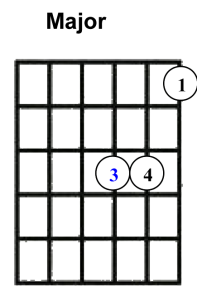Here I hope to start making sense of soloing over some of those chord progressions that have an odd chord smack dabb in the middle of it. I have another blog titled “How To Understand Weird Chord Changes” that talks about wrapping our heads around the chord functions. This blog is about how to solo over them. I’m going to use this chord progression:
C – E7 – Am – F
Practice the Applicable Arpeggio Over the Chord Change
So, I’m assuming we know the Key is C for the most part, (Not sure? Watch this video for an overview) outside of this weird E7 chord. How the heck are we suppose to solo of that chord? Start taking the scale position you’re comfortable with and find the closest E7 (or E) arpeggio to that scale shape and start practicing them one against the other.
I’m going to use our C major scale as an E alt shape. With the red note (root note) on the 8th fret, 6th string.
And our E7 arpeggio or E arpeggio as an A shape (5th string, 7th fret).
Start running the C major scale from the 6th string to the 1st string. Then the E7 (or E) arpeggio from the 1st string to the 6th string. Try that in reverse.
Next try 3 strings of the C major scale and 3 strings of the E7 (or E) arpeggio. Then 2 strings, then 1 string!
Try 4 notes of the C major scale, then 4 notes of the E7 (or E) arpeggio. 3 notes, 2 notes!
I think you’re starting to get the point.
Try To See Smaller Triad Shapes of the Chord Change.
Sometimes you don’t need the whole arpeggio, the chord goes by too quick to justify an arpeggio run or something of that sort. Visualizing a triad of the chord, E, is all you need. I’d pick something like this over the scale shape shown above. The root note (blue note) would be on the 3rd string, 9th fret.
Emphasize the Note That Isn’t In Our Scale
In working on the triad or arpeggio I notice the one note that isn’t in my C major scale but is in my E7 chord… that darn G# note. When that chord comes along in the progression, I really want to to emphasize the G# note. I can bend up to it, slide into it, but since that’s the main difference between the E7 and my C major scale I want to try to emphasize that note.
Also avoid the G natural at all costs over the E7, unless you already plan on bending that up a half step to G#.
There’s a lot of things we can do to analyze the proper scales and all that jargon. This is mostly for those looking for a quick fix for some of those weird chord changes that stick out here and there. I have some other video lessons and blogs that go into further details by clicking the “Theory” section on my Free Lessons page or Blogs page.
Although this is a simpler example, the same concepts work in even the most complex of cases.





